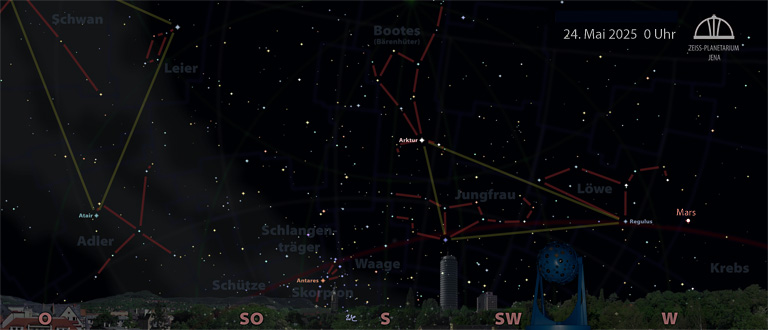Jupiter und Saturn am Abend und Venus und Mars am Morgen
Bereits zur Monatsmitte erklimmt die Sonne sommerliche Höhen und der helle Tag erreicht eine entsprechende Länge von 16 Stunden.
Am 12. Mai ist Vollmond, Neumond am 27.
Den Riesenplaneten Jupiter können wir vor dem Tierkreissternbild Stier im Westen entdecken. Es folgt der äußere Nachbarplanet, der rote Mars, vor dem Tierkreissternbild Krebs, ab 25. vor dem Tierkreissternbild Löwe.
Am westlichen Himmel zeigen sich noch die höherstehenden Sterne des Wintersechsecks wie Aldebaran im Stier, Kapella im Fuhrmann, die Zwillinge Kastor und Pollux und Prokyon im Kleinen Hund. Die anderen haben sich verabschiedet.
Am mitternächtlichen Himmel dominiert deutlich das Frühlingsdreieck den Süden. Es besteht aus Regulus im Löwen, Spika in der Jungfrau und Arktur im Bootes. Da es sehr ausgedehnt ist, sollte man den Großen Wagen hoch im Zenit zu Hilfe nehmen. Die Verlängerung des Deichselbogens weist zunächst auf den orangefarbenen Arktur – den dritthellsten am irdischen Himmel – und weiter auf die Spika. Das Trapez des Löwen selbst ist bei klarer Nacht kaum zu übersehen.
Hoch im Osten funkeln bereits die Sterne des Sommerdreiecks mit Deneb im Schwan, Wega in der Leier und Atair im Adler.
In der Morgendämmerung erscheint im Osten der sogenannte „Morgenstern“, unser nächster innerer Nachbarplanet, die helle Venus. Auch der Ringplanet Saturn erscheint Mitte des Monats am Osthorizont.
W. Don Eck
Zeiss-Planetarium Jena
The starry sky in May 2025
Jupiter and Saturn in the evening and Venus and Mars in the morning
By the middle of the month, the sun reaches summery heights and the bright day reaches a corresponding length of 16 hours.
There is a full moon on 12 May and a new moon on 27 May.
We can discover the giant planet Jupiter in front of the zodiacal constellation Taurus in the west. The outer neighbouring planet, red Mars, follows in front of the zodiacal constellation Cancer, and from the 25th in front of the zodiacal constellation Leo.
In the western sky, the higher stars of the winter hexagon such as Aldebaran in Taurus, Kapella in Charioteer, the twins Castor and Pollux and Prokyon in the Little Dog are still visible. The others have taken their leave.
In the midnight sky, the spring triangle clearly dominates the south. It consists of Regulus in Leo, Spika in Virgo and Arcturus in Bootes. As it is very extended, you should use the Big Dipper high in the zenith to help you. The extension of the drawbar arc points first to the orange-coloured Arcturus – the third brightest in the earthly sky – and then to Spika. The trapezium of Leo itself is barely visible on a clear night.
High in the east, the stars of the summer triangle are already twinkling with Deneb in the Swan, Vega in the Lyre and Atair in the Eagle.
At dawn, the so-called „morning star“, our nearest inner neighbouring planet, the bright Venus, appears in the east. The ringed planet Saturn also appears on the eastern horizon in the middle of the month.



